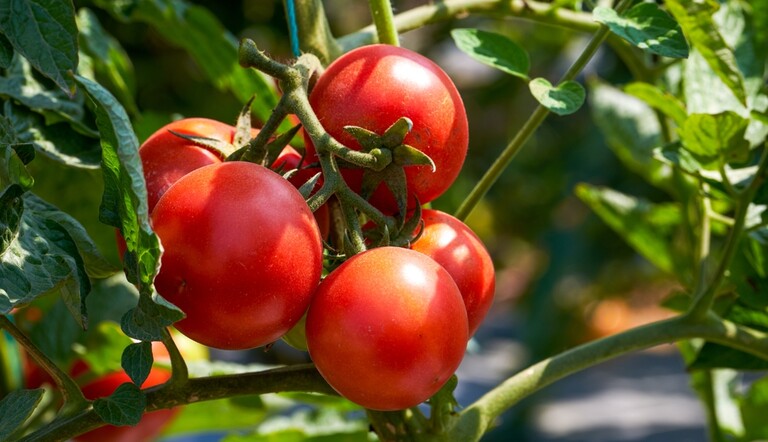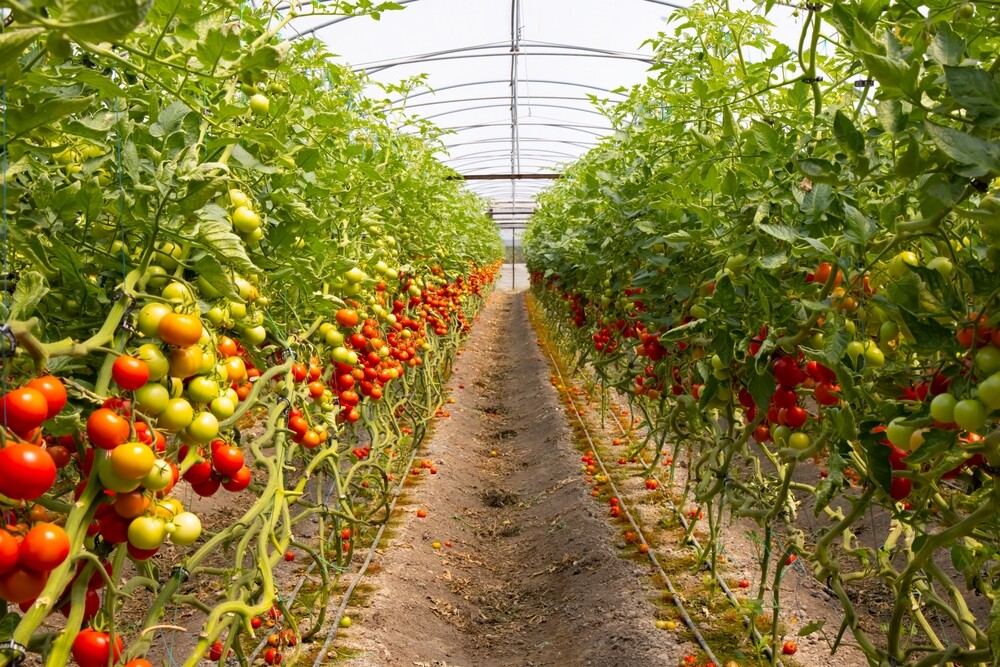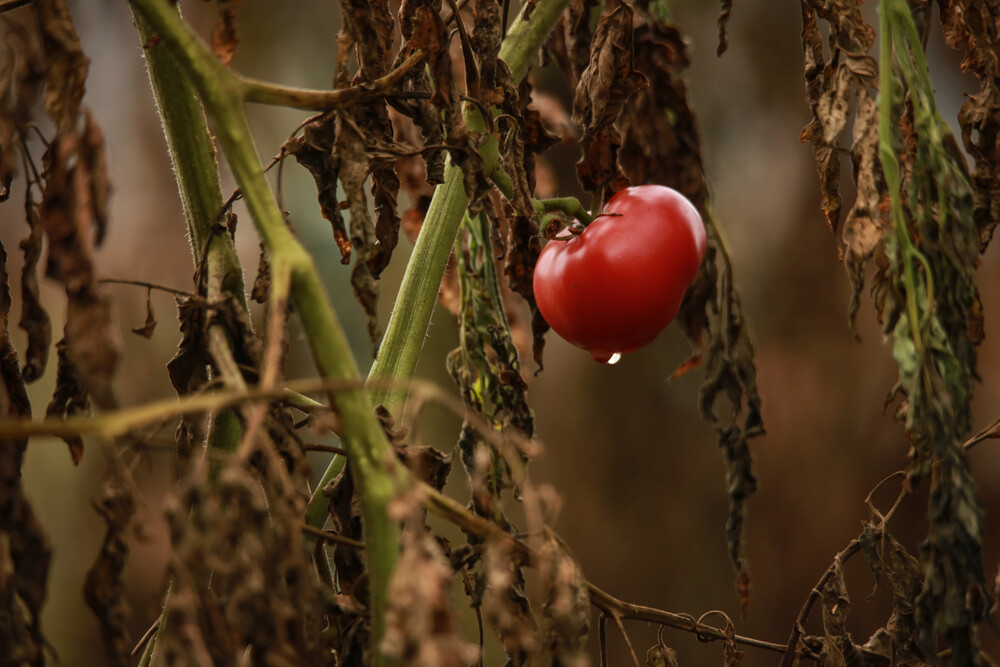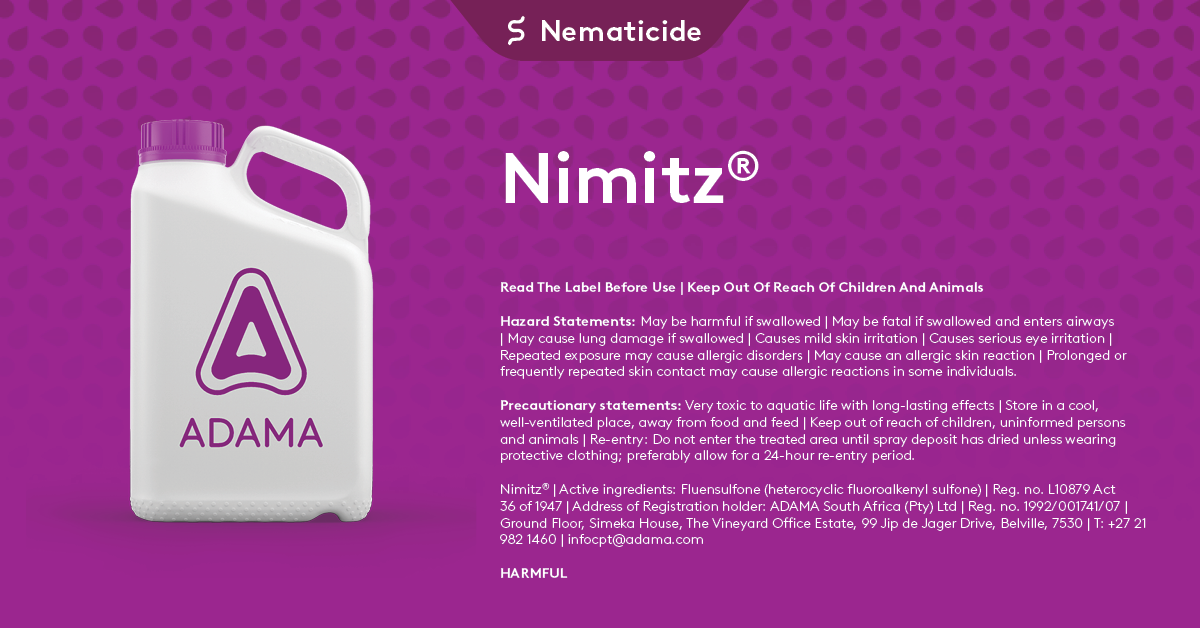
Tomato farming in South Africa

Tomato farming plays a significant role in the South African agricultural sector, contributing to both the economy and to food provision. Tomatoes are grown in several South African provinces, including Limpopo, Mpumalanga, North West, Western Cape, and Eastern Cape, with Limpopo being one of the largest producers.
Tomatoes thrive in warm conditions and require a well-drained, pH neutral soil. South Africa's climate is generally suitable for tomato cultivation, with the growing season varying by region. In warmer areas, tomatoes can be grown year-round, while in cooler regions, the growing season might be limited to the warmer months. New cultivars that fruit in winter open the door to opportunities that may allow farmers in cooler regions to produce tomatoes year-round.
The South African Department of Agriculture, Land Reform and Rural Development (DALRRD) supports the sector by developing and implementing legislation and by collaborating with various non-governmental agricultural organisations to improve production techniques, manage pests and increase market access for farmers.
Tomato Production in South Africa
Farmers in South Africa use both open-field and protected tomato cultivation methods, such as greenhouses and tunnel farming. The choice of method depends on several factors, including the climate, availability of resources, and the target market.
Some tomato plants (indeterminate growers) require a higher initial outlay in terms of labour and materials. These plants may offer a higher yield but are more costly to produce. Determinate types of tomato are less costly to plant and can be harvested mechanically but have specific growing requirements to prevent damage to the crop due to rainfall or other factors.
Greenhouse or tunnel cultivation, including hydroponic operations, allows for year-round production and can lead to higher yields due to controlled growing conditions. (Read The pros and cons of tunnel tomatoes by Bill Barr – a vegetable specialist who advises careful consideration before committing to tunnel cultivation).
Cultivars planted in South Africa
In South Africa, a diverse range of tomato cultivars are planted to cater to different market demands, climates and growing conditions. These cultivars vary in terms of size, colour, taste and resistance to diseases and pests. Some are better suited for fresh market consumption, while others are preferred for processing.
The choice of cultivar depends on factors like the intended market, climate tolerance, disease and pest resistance, and yield potential.
Here are some of the popular tomato cultivars planted in South Africa:
- The Heinz 1370 cultivar is widely used for both fresh market and processing due to its good flavour and firmness.
- For fresh market purposes, Rodade with its uniform colour and good shelf life, the disease resistant STAR 9001 and the heat tolerant Fioradade are popular choices. Cherry and cocktail tomatoes such as Sugary and Santa are considered ideal for salads.
- Roma VF plum tomato and UC82B are frequently chosen for processing.
- Specialty and Heirloom varieties that have recently been less popular due to lower resilience, a lower yield and higher susceptibility to disease, are also making a comeback. Cultivars such as Brandywine, Cherokee Purple and Green Zebra are favourites among avid gardeners and organic producers. These varieties are prized for their unique flavours and colours but might not be as widely grown commercially.
The popularity and usage of specific tomato cultivars can change over time, based on evolving agricultural practices, market demands and the introduction of new hybrids designed to offer improved yield, disease resistance and climate adaptability. Farmers and producers continuously experiment with and adopt different cultivars to meet specific needs and preferences.
Imports and exports
The domestic market for tomatoes in South Africa is strong, with tomatoes being a staple food in many households. There is also a growing export market, with South African tomatoes being exported to neighbouring countries and beyond. However, meeting the export quality standards and competition from other countries can be challenging for local farmers.
The import and export dynamics of tomatoes in South Africa are influenced by several key factors that affect the country's ability to participate in international markets as well as meet domestic demand. South Africa primarily aims to satisfy its domestic demand for tomatoes through local production. Depending on the season and production levels, the country may import tomatoes to cover shortfalls in domestic supply or export excess production.
Import and export activities can be highly seasonal and influenced by the local production cycle. During peak harvest times, South Africa might have a surplus for export, while during off-peak times, it might need to import tomatoes to meet local demand.
The country's trade in tomatoes involves neighbouring countries and others within the African continent. Exported tomatoes must meet the quality standards of the destination countries, and similarly, imports must comply with South African standards to ensure they are safe for consumption and do not introduce pests or diseases.
To protect local agriculture, South Africa enforces strict phytosanitary regulations on the import of agricultural products, including tomatoes. These regulations require that imported tomatoes be free from specific pests and diseases and may require certification from the exporting country's agricultural authorities.
There are opportunities for South Africa to expand its tomato exports, especially to markets with high demand but insufficient local production. Investing in technologies for extended shelf life, improving supply chain efficiency, and meeting international certification standards can enhance export competitiveness.
Outlook for South Africa’s tomato industry
The current outlook for South Africa's tomato industry reflects a mix of challenges and opportunities. In recent years, there has been a noticeable fluctuation in tomato production volumes and prices, influenced by various factors including climate conditions and market demands. According to agricultural analytics company Tridge, the country ranks 40th in global tomato production, showcasing a considerable contribution despite challenges such as a decline in production volume over the past five years.
Import dynamics have shown a robust growth, with 2022 marking a peak in both volume and value of tomato imports into South Africa. This surge was primarily attributed to increased imports from Namibia. This trend, reported in the South Africa: Tomato Market Report, 2024, underscores the buoyant expansion of imports over the years, indicating a strong demand for tomatoes within the country.
The industry has faced its share of challenges, notably due to weather conditions. Heavy rainfall across some of South Africa's tomato production regions as far back as 2021 resulted in a temporary shortage of tomatoes, leading to a sharp increase in prices. Despite such setbacks, the prospects remain positive due to the beneficial impact of the rains after previous drought conditions.
While climate-related challenges and import dependencies present hurdles, the resilience of the sector and its capacity to adapt suggest potential for growth. Water scarcity, especially in drought-prone areas, requires efficient irrigation techniques and water management practices to ensure sustainable production.
Pests and diseases for tomatoes
A variety of pests and diseases can also significantly impact tomato crops. These pests can cause a range of issues, from leaf and stem damage to affecting the plant's ability to produce fruits or vegetables. Pests like the tomato leaf miner (Tuta absoluta) and diseases such as tomato spotted wilt virus pose significant threats to production. Nematodes are a significant component of soil ecosystems and can lead to stunted growth, failure to thrive and premature wilting.
In terms of diseases, South African tomato growers must be vigilant against bacterial spot (Xanthomonas vesicatoria), early blight (Alternaria solani), late blight (Phytophthora infestans), fusarium wilt (Fusarium oxysporum f. sp. lycopersici), verticillium wilt (Verticillium dahliae), tomato mosaic virus (TMV), and tomato yellow leaf curl virus (TYLCV). These diseases can lead to symptoms ranging from leaf spots and wilting to stunted growth and reduced yields. Additionally, diseases like powdery mildew (Oidopsis taurica) are also a concern, often affecting the plant's leaves and potentially leading to significant crop loss.
To manage these pests and diseases, multipronged integrated pest management strategies such as the use of resistant varieties, proper crop rotation, maintaining good field hygiene, and applying appropriate chemical controls is necessary. Ensuring good air circulation, avoiding overhead watering, and monitoring the crops regularly for early signs of infestation or disease can also help in minimising the impact on tomato production.
ADAMA’s crop protection
Nimitz® is a unique nematicide, formulated to target only plant-parasitic nematodes while retaining the balance of the soil’s ecosystem. It can be used with confidence for crops such as tomatoes, potatoes, marrows and squash, and melons. Additionally, it is effective within 24-72 hours and is considered non-toxic to birds, bees, and aquatic life.
Other useful ADAMA products for use by tomato producers include Sphinx® Star WDG fungicide, a prophylactic fungicide that controls late blight and botrytis rot on tomatoes, Acetastar® 46 EC insecticide a fast acting insecticide for the control of difficult pests, Devipan™ 100 insecticide an emulsifiable concentrate insecticide with a short residual action, and the fast-acting Pyrethroid Klartan® 240 EW insecticide which has a low toxicity to bees and predatory insects.
For pests resistant to other products, Warlock® 19.2 EC insecticide is ideal and provides excellent management of phytosanitary pests.
ALWAYS READ THE LABEL BEFORE USING CROP PROTECTION AND KEEP OUT OF REACH OF CHILDREN AND ANIMALS
The links to the labels of each product mentioned above are below, along with hazard and precautionary statements.
WARNING
Hazard statements:
May be harmful if swallowed. May be fatal if swallowed and enters airways. May cause lung damage if swallowed. Causes mild skin irritation. Causes serious eye irritation. Repeated exposure may cause allergic disorders. May cause an allergic skin reaction. Prolonged or frequently repeated skin contact may cause allergic reactions in some individuals.
Precautionary statements:
Very toxic to aquatic life with long-lasting effects. Store in a cool, well-ventilated place, away from food and feed. Keep out of reach of children, uninformed persons and animals. Re-entry: Do not enter the treated area until spray deposit has dried unless wearing protective clothing; preferably allow for a 24-hour re-entry period.
NIMITZ® | Active ingredients: Fluensulfone (heterocyclic fluoroalkenyl sulfone) | Reg. no. L10879 Act 36 of 1947 | Address of Registration holder: ADAMA South Africa (Pty) Ltd | Reg. no. 1992/001741/07 | Ground Floor, Simeka House, The Vineyard Office Estate, 99 Jip de Jager Drive, Belville, 7530 | T: +27 21 982 1460 | infocpt@adama.com
FIND THE SPHINX® STAR WDG LABEL HERE
CAUTION
Hazard statements:
Handle with care. Harmful if swallowed. Toxic to fish and wildlife. Store in a cool, dry place away from food and feed. Store away from sources of ignition (no smoking) and keep away from combustible material. Keep container closed when not in use. Keep out of reach of children, uninformed persons and animals. May cause sensitization by skin contact. Re-entry: Do not enter treated area until spray deposit has dried off.
Precautionary statements:
Wear gloves and face shield when handling the concentrate. Do not inhale fumes or spray mist. Avoid prolonged contact with skin and eyes. If eyes are contacted, flush out at once with clean running water. If skin is contacted, wash immediately with soap and cold water. Wash exposed body parts with soap and cold water after use and wash contaminated clothes daily. Do not eat, drink or smoke while mixing, applying or before washing hands and face. Clean spray equipment after use and dispose of wash water where it will not contaminate crops, grazing, rivers or dams. Avoid drift of spray mist to other crops, grazing, rivers, dams and areas not under treatment. All empty cartons to be destroyed through burning should be completely empty. Do not allow humans and animals to come in contact with the smoke and/or fumes. Prevent contamination of food, feedstuffs, drinking water and eating utensils.
SPHINX® STAR WDG | Active ingredients: Dimethomorth (cinnamic acid derivative), Chlorothalonil (phthalonitrile) | Reg. no. L9084 Act 36 of 1947 | Address of Registration holder: ADAMA South Africa (Pty) Ltd | Reg. no. 1992/001741/07 | Ground Floor, Simeka House, The Vineyard Office Estate, 99 Jip de Jager Drive, Belville, 7530 | T: +27 21 982 1460 | infocpt@adama.com
FIND THE ACETASTAR® 46 EC LABEL HERE
HARMFUL
Hazard statements:
Harmful if swallowed. May be fatal if swallowed and enters airways. Causes serious eye damage. May cause drowsiness or dizziness. Suspected of causing cancer. Very toxic to aquatic life with long lasting effects. Flammable liquid and vapour.
Precautionary statements:
Do not eat, drink or smoke when using this product. Keep away from heat, hot surfaces, sparks, open flames and other ignition sources.
ACETASTAR® 46 EC | Active ingredients: Acetamiprid (neonicotinoids), bifenthrin (pyrethroid) | Reg. no. L10879 Act 36 of 1947 | Address of Registration holder: ADAMA South Africa (Pty) Ltd | Reg. no. 1992/001741/07 | Ground Floor, Simeka House, The Vineyard Office Estate, 99 Jip de Jager Drive, Belville, 7530 | T: +27 21 982 1460 | infocpt@adama.com
FIND THE DEVIPANTM 100 LABEL HERE
TOXIC
Hazard statements:
Flammable liquid and vapour. Toxic if swallowed. May be fatal if swallowed and enters airways (aspiration hazard). Fatal in contact with skin. Causes skin irritation. May cause allergic skin reaction. Causes serious eye damage. Fatal if inhaled. Suspected of causing cancer.Very toxic to aquatic life.
Precautionary statements:
Keep away from heat, hot surfaces, sparks, open flames, and other ignition sources. No smoking. Wear protective gloves, eye, and face protection.
DEVIPANTM 100 | Active ingredients: dichlorvos (organophosphate) | Reg. no. L10879 Act 36 of 1947 | Address of Registration holder: ADAMA South Africa (Pty) Ltd | Reg. no. 1992/001741/07 | Ground Floor, Simeka House, The Vineyard Office Estate, 99 Jip de Jager Drive, Belville, 7530 | T: +27 21 982 1460 | infocpt@adama.com
FIND THE KLARTAN® 240 EW LABEL HERE
CAUTION
Hazard statements:
Very toxic to aquatic life with long lasting effects.
Precautionary statements:
Avoid release to the environment. Collect spillage.
KLARTAN® 240 EW | Active ingredients: tau-fluvalinate (pyrethroid) | Reg. no. L10879 Act 36 of 1947 | Address of Registration holder: ADAMA South Africa (Pty) Ltd | Reg. no. 1992/001741/07 | Ground Floor, Simeka House, The Vineyard Office Estate, 99 Jip de Jager Drive, Belville, 7530 | T: +27 21 982 1460 | infocpt@adama.com
FIND THE WARLOCK® 19.2 EC LABEL HERE
Hazard statements:
May be fatal if swallowed and enters airways. May cause an allergic skin reaction. Causes serious eye damage. May damage fertility or the unborn child. May cause damage to organs through prolonged or repeated exposure. Very toxic to aquatic life with long lasting effects.
Precautionary statements:
Wear protective gloves; protective clothing; eye protection and face protection. Avoid release to the environment.
WARLOCK® 19.2 EC | Active ingredients: Bifenthrin (pyrethroid), Novaluron (benzoyl urea) | Reg. no. L10879 Act 36 of 1947 | Address of Registration holder: ADAMA South Africa (Pty) Ltd | Reg. no. 1992/001741/07 | Ground Floor, Simeka House, The Vineyard Office Estate, 99 Jip de Jager Drive, Belville, 7530 | T: +27 21 982 1460 | infocpt@adama.com





